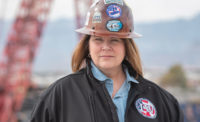The Riddle
What do the Charles Pankow Foundation, the Council on Tall Buildings and Urban Habitat, and Funny Undies have in common?
The Answer
Ron Klemencic
Through his whimsical Funny Undies campaign in college, structural engineer Ron Klemencic launched himself not only as a leader but as an ideas man, problem-solver and fundraiser. As president of Purdue University’s student chapter of the American Society of Civil Engineers, he hatched and executed a plan to sell boxer shorts to students as a way to underwrite the ASCE group’s senior class trip to Chicago from West Lafayette, Ind., to visit infrastructure, buildings and design firms.
Each order was decorated with a fun graphic such as polka dots, watermelon slices, the school logo or its mascot, Purdue Pete. Klemencic rallied his cohorts to blanket the campus with Funny Undie posters, hand out flyers, take orders, silkscreen briefs at night in the borrowed materials lab and make deliveries.
“The name and the whole campaign was my idea,” says Klemencic, chairman and CEO of the 190-person Magnusson Klemencic Associates Structural + Civil Engineers (MKA). “We raised thousands of dollars.”
Fast forward to the beginning of the new millennium, when Klemencic was president of MKA’s predecessor firm, Skilling Ward Magnusson Barkshire (SWMB). Through his 2001-06 tenure as the volunteer chairman of the nonprofit Council on Tall Buildings and Urban Habitat, Klemencic revived the global authority on high-rises, which was in dire straits after the retirement of its founder, Lynn Beedle. In doing so, Klemencic established himself as a consummate communicator and collaborator.
“For the first time, I was sitting in a leadership seat, on a global stage and engaging with members of the buildings community, including my structural-engineer competitors, to come together as volunteers to make the world better,” says the 55-year-old engineer.
Funny Undies and the council experiences informed his next major pro bono effort. Since 2008, Klemencic has been the “poster practitioner” of the nonprofit Pankow foundation, which uses its $30-million private endowment to underwrite public-domain research and development (R&D) collaborations.
“Pankow serves as a nexus around which transformative innovations and technology have begun to emerge, be funded and advance into the marketplace,” says Klemencic, who is a director of the group.
Witness Klemencic’s cutting-edge office tower superstructure. The composite steel system is expected to take 40% less time to build than a steel frame with a reinforced concrete core. A decade ago, Klemencic championed Pankow-funded lateral load tests that resulted in design guidelines for the system’s core walls, consisting of stacked modules of cross-tied steel plates field-filled with rebar-less concrete.
Rainier Square Tower, the system’s 850-ft-tall “proof of concept,” is getting underway in Seattle (ENR 12/25/17-1/1/18 p. 18). “Rainier Square [combines] my insatiable search for ‘better,’ and passions for R&D and intense collaboration with the building team to create a breakthrough,” says Klemencic.
The radical core is engineered using an earlier paradigm shift in global practice, also triggered by Klemencic, called tall-building performance-based seismic design. PBSD is a sophisticated methodology that results in safer, better-performing and more cost-effective high-rises in earthquake zones.
Klemencic envisions single-project BIMS in the ‘cloud,’ accessible to a project team. He sees structural steel twice as stiff, resulting in smaller, shallower sections. He imagines routine structural fire engineering that allows exposed structures, widespread modular construction and routine robotic construction.
Klemencic organized, with Pankow funding, the development of the 2010 tall-building PBSD guidelines. Tall-building PB wind design is next on his list. Last month, Pankow and ASCE announced a Pankow-funded initiative, brokered by Klemencic, that promises to put PBWD on the global map.
“Ron has been a tireless advocate, advancing research into practice and making research publicly available so we can all learn from it,” says Tom Smith, ASCE’s executive director.
For daring to innovate, for spearheading the age of cooperative R&D and for his relentless pursuit of a better and more constructible built environment, Klemencic has been voted the 53rd Award of Excellence winner by the editors of Engineering News-Record.
“I view Ron as a really great catalyst and a visionary, with a very intuitive feel for the way things should be,” says Ronald O. Hamburger, a senior principal with engineer Simpson Gumpertz & Heger and a strategic collaborator on the PBSD guidelines. “He is great at bringing people together to resolve problems.”
Amit H. Varma, director of the Robert L. and Terry L. Bowen Laboratory at Purdue, adds, “Ron’s work is benefiting not just himself, his alma mater, his company, his client or a building project. His work is benefiting an entire industry.” Varma is co-lead investigator, with Michel Bruneau at the University at Buffalo, on a second round of composite steel-plate-module lateral load tests, expected to fine-tune the system. The research product will be improved design guidelines.
“This project has the potential to have the most impact” of Pankow’s 72 projects, says Mark J. Perniconi, Pankow’s executive director.
Klemencic, formerly known as a “concrete guy,” convinced the American Institute of Steel Construction to match Pankow’s $300,000 for the project. AISC is thrilled about the system’s potential to “steel” the show from concrete cores. “We want to support big changes in the marketplace” for the steel sector, says Charles J. Carter, AISC’s president.
Klemencic has been involved with 25 Pankow projects since becoming a director in 2008. “We invited Ron to join the board because he is passionate about improving the design and construction of buildings, has deep structural engineering expertise and has broad vision about industry trends,” says Richard M. Kunnath, Pankow’s president. He has become “indispensable,” he adds.
For his MKA job, Klemencic typically leads 20 projects at a time. To get everything done, he sleeps just four hours a night. “Ron is chairman of a major company, which is a full-time job,” says Jack Moehle, a professor of structural engineering at the University of California, Berkeley, who was also instrumental in creating the PBSD guidelines. “That he finds time to manage this other seemingly full-time job with Pankow, be involved in code development and participate in research is really impressive.”
Klemencic is about to do even more. Dissatisfied with small steps forward, he is launching his next big crusade. “Our industry is sorely in need of innovation and advancement,” he says. “What has been good enough isn’t good enough anymore.”
Klemencic, the change agent, is calling for a national R&D collective, funded by developers, architects, engineers, contractors, product and materials suppliers and trade groups. “I call upon the industry leaders to make a change,” he says. “Imagine what might be possible if we all got involved.”
Klemencic envisions single-project BIMs in the “cloud,” accessible to a project team. He sees structural steel twice as stiff, resulting in smaller, shallower sections. He imagines routine structural fire engineering that allows exposed structures, widespread modular construction and routine robotic construction.
Related Articles:
Mock-Up Work Raises Confidence in Radical Steel Structure
Engineer Continues to Thrive Under Klemencic's Baton
Effect Change Tomorrow
“We are not talking about fundamental research,” he says. “We are trying to get the ball from the red zone to the end zone, to effect change tomorrow.”
Klemencic hopes to scale up Pankow’s impact, beyond its $12 million invested in R&D since 2006. “If each firm allocated 2% of its annual profits, we could devote more than $200 million per year [to develop new methodologies and technologies],” he says. Last fall, to start the ball rolling, MKA’s partners created the Magnusson Klemencic Associates Foundation, funded by 2% of MKA’s annual profits. To date, the foundation has given $100,000 each to two PBWD initiatives.
 |
|
The Big Boss Klemencic at work in MKA’s Seattle headquarters (photo left), on a project site in Doha (photo center), and at wind engineer RWDI in Guelph, Ontario. PHOTOS COURTESY MKA |
Klemencic’s conversion to research evangelism was initially born out of building officials’ resistance to MKA’s innovations. That prompted him to encourage clients, on a project-by-project basis, to fund lab research to validate better ways to build. His epiphany about cooperative research—involving competitors—came after he tried to get approvals for the first two PBSDs in San Francisco. Both granted in 2005, the approvals took two years for the Infinity’s 38- and 48-story towers and one year for the 64-story One Rincon Hill. The norm, by comparison, is six months.
“That’s when a light bulb went on,” he says. Innovating “in a little bubble by yourself has merit, but if an innovation is going to have a wide impact, competitors need to stop trying to outdo each other and join together to work for everyone’s benefit,” he adds.
Soon after, Pankow funded a project that involved nine structural engineers, including Klemencic. The result was the 84-page Tall Buildings Initiative Guidelines for PBSD of Tall Buildings. The 2010 guidelines, by the Pacific Earthquake Engineering Research Center, were updated last year. PBSD for tall buildings is now the standard—around the world.
“Twenty years ago, we would hardly talk to other engineers and now we are working together to create the next best great thing,” says John Hooper, MKA’s director of earthquake engineering.
Before his conversion, the 6-ft, 6-in. Klemencic was a standout, but only to his project teams. “He’s a rock star,” says Paul Paradis, a senior managing director for the developer Hines, a repeat MKA client. “For any world class project of scale, I couldn’t imagine not having Ron on the team. His creativity and problem-solving skills are second to none.”
Calling Klemencic “an architect’s structural engineer,” Clark Manus, CEO of Heller Manus Architects, and the one who inspired Klemencic to pioneer PBSD in San Francisco, adds, “PBSD helped produce a more beautiful building with a more efficient layout.”
The engineer attributes his intense drive to succeed to a fear of failure that stems from not wanting to disappoint his late mother, Doris, a school teacher. He says he got his strong work ethic from his father, Ron, who is 79. The elder Klemencic worked in shipping and receiving for the Heinrich Co., a toolmaker in Racine, Wis., where the family of four, including younger sister Kim, lived a modest life.
Klemencic was a model son and student, except for a rebellious year in junior high, when he started hanging around an unsavory crowd—drinking, doing drugs and playing keyboard in a rock ’n’ roll band. “I am often tempted to push boundaries,” he says.
In high school, he stopped his downward trajectory. “For the first time, I felt I had the power of self-control and the ability to make choices,” he says.
Though he decided to become a tall-building structural engineer in eighth grade, Klemencic, who was a star athlete, says his one regret is not pursuing a career in volleyball. He gave it up at the encouragement of his mother, who saw no money in it.
Despite great grades in high school, he was rejected from Purdue’s freshman engineering class. Undaunted, Klemencic immediately applied and was accepted to the construction management school. He transferred into engineering after freshman year. In 2013, he won a distinguished engineering alumni award.
“I thought Ron was a standout, but I never thought he would have the kind of success he has had,” says Mark D. Bowman, Klemencic’s professor at Purdue, who later co-led the first round of module tests.
Small Fish, Big Pond
After his 1985 graduation, Klemencic enrolled at the University of California, Berkeley, to pursue a master of science in civil engineering. He felt like a small fish in a big liberal pond. Early on, he was in a structural analysis class of about 80 students. After writing a problem on the chalk board, the esteemed professor, the late Alex Scordelis, turned and said, “Mr. Klemencic from Purdue University, what do you have to say about this?” Caught off guard, he blurted out the wrong answer. “Professor Scordelis looked at me and said, ‘They didn’t teach you much at Purdue, did they?’ ” says Klemencic. A few days later, he had a meltdown. But he powered through the crisis, got straight A’s and graduated in 1986.
 |
|
Life Forces In his active youth, Klemencic was on the go and flying high, whether riding a trike or spiking a volleyball. PHOTOS COURTESY RON KLEMENCIC |
In 1988, Klemencic moved to Seattle. He worked for KPFF Consulting Engineers. In 1992, he joined SWMB, which was known for tall buildings.
As a young engineer, Klemencic was like “a wild horse,” says Jon Magnusson, MKA’s chairman emeritus and a senior principal. “I watched this bucking bronco turn into a thoroughbred,” says Magnusson, who led the practice for 25 years. Klemencic credits Magnusson, who became his mentor, for his metamorphosis. “If there is one thing that was the catapult, it was Jon seeing something in me, unusual enough to inspire him to hire me and shape me,” he says.
Magnusson’s firm philosophical views on business ethics and the structural engineering profession and its place in the world still serve as a guide, informing tough decisions based on logic, not emotion or the “flavor of the week,” says Klemencic.
Soon after he started at SWMB, he traveled all over Southeast Asia to pursue jobs and work on high-rise projects. Initially, he learned the ropes from the late John Skilling, Magnusson’s mentor. Skilling, who died in 1998, was known as a high-rise specialist. That started in the early 1960s, when he beat out a gaggle of New York City-based tall-building structural engineers to design the first World Trade Center, with its twin 110-story towers. Before the WTC, Skilling had never designed a building taller than 20 stories.
In parallel with his early wanderings, Klemencic became involved with the tall buildings council, which he viewed as a way to expand his global network. He chaired the council’s sixth world congress in early 2001, in Melbourne, Australia. The gathering was considered a success, which led to Beedle’s invitation to Klemencic to lead the council itself.
Two months after he became chairman, on Sept. 11, 2001, terrorists destroyed the WTC’s 110-story towers by attacking them with hijacked planes traveling at more than 500 mph. Predictions abounded that the era of the skyscraper was at an end, in part because iconic towers stood out as targets for terrorists. As the spokesman for the council, Klemencic was thrust into the debate and the media spotlight. He calls the experience “traumatic” but says he learned important lessons about crisis management on a global stage.
As a consequence of his council work and his growing emphasis on business development at MKA, Klemencic drifted away from technical engineering. He tells of a rude awakening one day at a peer review meeting for the Infinity. Structural engineer Loring Wyllie, a member of the review panel, said bluntly, “This is the worst set of calculations I have ever seen.”
Klemencic, who had gone into the meeting without so much as glancing at the calculations, was devastated. “All of the air went out of the room,” he says. “I had nowhere to hide.” Wyllie inadvertently had taught him a valuable lesson, which changed his career trajectory. Since then, he is “very deeply” engaged in all of his projects.
His accomplishments aside, Klemencic says he does not know what “ultimate success” looks like. “Every time I reach a milestone,” he says, “there’s a new one” ahead. That is fine with his admirers, for whom Klemencic is a symbol of hope. “This is just the beginning,” says Purdue’s Varma. “Over the next two decades, we want to see Ron take us in directions we would never have imagined.”













Post a comment to this article
Report Abusive Comment